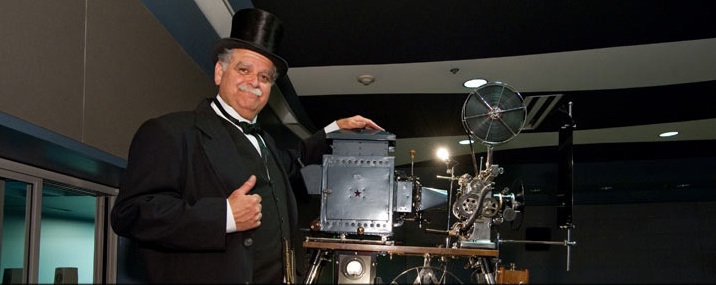Since 2003, Randy Haberkamp, Director of Public Programming and Educational Outreach at the Academy of Motion Picture Arts and Sciences, has annually been presenting a unique and fascinating survey of early cinema at the turn of the last century. This year’s program, “A Century Ago: The Films of 1911,” is subtitled “Heroes and Heroines,” and will be presented next week, Monday, November 7th, starting at 7:30 PM at the Academy’s Linwood Dunn Theatre in Hollywood.
This may be one of the only program of this kind in the world to be presented on a 1909 hand-cranked Power’s Model 6 Cameragraph motion picture machine (!), restored and cranked by historian Joe Rinaudo. It will also feature live musical accompaniment by Michael Mortilla. Lucky cinephiles in the Los Angeles area SHOULD NOT PASS UP this unique cinematic opportunity!
“A Century Ago” will also be presented at the Smith Rafael Film Center in San Rafael, California on November 21st at 7 PM.
We recently had the chance to speak with Randy, as he was previewing the films, along with Academy Film Archivist Brandee Cox, in preparation of next week’s show.
Director of Public Programming, Randy Haberkamp, and Academy Film Archivist, Brandee Cox, preview the Films of 1911 Program
Flicker Alley: It could be said that each year during the first two decades of cinema had ground-breaking things happening during it. What is momentous about the year 1911 as it relates to cinema history? Is it the establishment of the star system or the strong move away from studio productions to having locations be more integral to the plot?
Randy: Yes, both the establishment of the star system and shooting on location were momentous shifts in 1911. The star system really did explode in 1911. The studios embraced the concept of marketing popular personalities and pushing their names. There was also an explosion of people moving out to various locations for filming, partially to have distinctive settings but also for privacy and to protect the evade the corporate patent entanglements of the motion picture trust.
The other aspect of cinema history that is really notable from 1911 is the larger embrace of fan culture. Before this year, there were trade magazines, but in 1911, magazines directly produced for the fan, specifically covering motion picture stories and accentuating the star culture of popular players.
Flicker Alley: What’s one aspect about the emergence of the ‘star system’ that might be most surprising to audiences today? (Follow up: Regarding this new phenomenon in 1911, what has changed and has anything about it stayed the same to this day?)
Randy: What stayed the same between 1911 and 2011 is that audiences and producers are very fickle. There were some popular film players in 1911 that were forgotten within a couple of years. Some filmmakers were able to make an impression and many others fell by the wayside.
It is surprising that the star system has largely remained the same. The scandal and salary demands of today were already happening then. Florence Lawrence was already on her third studio deal, going for bigger dollars. The first big scandal hit in 1911 when filmmaker Francis Boggs was shot and killed in the Selig Studio. And there were lots of sequels, remakes and producers copying previous hits. The more things change, the more they stay the same.
Flicker Alley: Today major studios tend to market much of their studio products to an age 18-35 demographic. What was the movie-going audience like in 1911 demographically? Who was predominantly watching these films? (Follow up: How were films marketed and promoted in 1911?)
Randy: In 1911, the studios were basically marketing to everyone, but they also knew that many in the audience were new to the country. Many movies were aimed to lower middle-class immigrants. It was very inexpensive entertainment that changed regularly–mass entertainment which really had not existed before. Studios also made a conscious effort to bring women into the audience with heroines played by Mary Pickford and Blanche Sweet, for example. These were very different heroines. They didn’t always need to be rescued and were very much in the center of their own stories. A lot of the women were expected to go out on location and do their own stunts. It was really quite an adventure.
Flicker Alley: Who’s a “star” from 1911 that you personally are most fascinated by?
Randy: Kathlyn Williams, one of Selig’s first big stars. She was a popular actress and heroine and later appeared in some of the earliest serialized stories. She was also a real trooper, heading out West. We are showing a film fragment that shows a film crew driving in a truck and heading to a location to shoot. They are shooting with only a camera. That’s it, just a camera. You can see this “Let’s make a movie spirit” at the time, and you think to yourself “Wow, these people really had guts.” The actors weren’t thinking “Where’s my stuntman?” They were ready to jump into danger. During the shooting ofLost in the Jungle, which will be screened next Monday, Kathlyn was actually attacked by a leopard. But secretly I must say that Jean the Vitagraph dog is my favorite 1911 film star. She opened the door for all the canine stars.
Flicker Alley: This is the ninth year that the Academy has been presenting the “A Century Ago” program. Looking forward, how do you see the series expanding and changing as you begin to deal with long form, narrative and/or “feature length” cinema?
Randy: Yes, it is the ninth year. I am dealing with the program on a year to year basis. I literally spend an entire year on it and get input from colleagues and others. I see what stories and information I can gather. I also develop the shows based on what films survive and what condition they have survived in since only about 10% of the films from this period still exist. It’s heartbreaking reading some of the magazines and realizing that the majority of the films are lost.
Flicker Alley: The Academy’s program is unique among archival institutions in the way they are presented on an original hand-cranked project equipment from the era. What’s the most striking feedback that you receive from audiences that have seen the films presented this way?
Randy: The hand-cranked projector is an antique for my generation. What is fascinating about if for me is to see how even more foreign it is to some people in their 20s and 30s that have no relation to the projector as a cinematic device because they are so used to DVDs and online videos.
Seeing this hand cranked projector up close, the most primitive projection apparatus in its rawest form, is fascinating. And the audience loves seeing how the projectionist can control the speed of film. It is like seeing what is behind the magician’s tricks.
Flicker Alley: What do you think is the value of looking at films from a century ago?
Randy: What is relevant is that on the one hand these films from a century seem completely foreign. You really need to know what you are looking at…it’s like a film in a different language. When you study these films a little bit, you realize that what we think about in 2011 as filmmakers and filmgoers is the same. It is valuable to see film stripped down to its most naked essentials…to see what makes film fun and to see what makes film work.
Thanks to Randy Haberkamp and Brandee Cox for letting us get a sneak peak at Monday night’s program.





